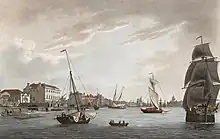Royal Hibernian Marine School
The Royal Hibernian Marine School, also known for a period as Mountjoy & Marine School, was a charity school in Dublin, Ireland established in 1766 to care for and educate the orphaned children of seamen.[2][3] The school's building on Sir John Rogerson's Quay was in use as a school from 1773 until 1904 and continued to be used as offices and storage until the 1970s before being demolished in 1979.
| Royal Hibernian Marine School | |
|---|---|
.jpg.webp) Illustration of the building from circa 1780. | |
 | |
| Former names | Hibernian Marine School |
| Alternative names | Marine Nursery |
| General information | |
| Status | Demolished |
| Type | School |
| Architectural style | Georgian |
| Address | Sir John Rogerson's Quay |
| Town or city | Dublin |
| Country | Ireland |
| Coordinates | 53.3461°N 6.2421°W |
| Groundbreaking | 1770 |
| Completed | 1773 |
| Demolished | 1979 |
| Cost | £6,000[1] |
| Technical details | |
| Material | granite |
| Floor count | 3 |

School
History
The first meeting of the board of the school took place on 6 June 1766 in the then operating Custom House on what was at that time named Custom House Quay (now Wellington Quay).
In 1775, the school obtained a royal charter.[4]
The school building was damaged by fire in 1872 causing damage and resulting in the school moving premises.[5] In 1900 it was situated on Upper Merrion Street while in 1904, the school moved to Seafield Road in Clontarf, where the Seacourt estate now stands.[6][7][8]
The school amalgamated with Mountjoy School in 1968 and became Mountjoy & Marine School. Mountjoy School was a protestant boarding school previously located on Mountjoy Square which had moved to a new premises in Clontarf in 1947.[9]
The school later amalgamated with Bertrand and Rutland School to finally become Mount Temple Comprehensive School in 1972.[10][11]
Sport
In 1910, the school won the inaugural Leinster Cricket Union Junior cup. Teams representing the school also won the competition on a number of other occasions.[12][13]
New building
The school originally operated from a leased coach-house and inn building near the junction of Ringsend and Irishtown named 'The Sign of the Merrion'.[14]
In 1769, the governors of the school leased a plot of land on Sir John Rogerson's Quay from Luke Gardiner for a term of £70 per annum.[15] From various sources including parliament and private doners, the governors of the school managed to raise enough funds to construct the new building between 1770-73.[16][17] It was one of the first large buildings to be constructed on the recently completed quay.
One of the school wings operated as a chapel while the other operated as a school room with the main building housing the children.[18]
Most sources attribute the building's design to the architect Thomas Cooley,[19] while others attribute it to Thomas Ivory.[2]
An image of the building standing on the quay features in James Malton's illustrations titled A Picturesque and Descriptive View of the City of Dublin drawn in about 1790 not long after the building was erected.
The building operated as the offices of the B&I Line for a number of years as well as the offices of a cold storage company before being demolished in 1979.[2]
References
- "The Hibernian Magazine, Or, Compendium of Entertaining Knowledge". James Potts. 1783. Retrieved 18 January 2023.
- "1773 – Hibernian Marine School, Dublin". Archiseek - Irish Architecture. 14 December 2011. Retrieved 5 July 2021.
- Quane, Michael (1967). "The Hibernian Marine School Dublin". Dublin Historical Record. 21 (2): 67–78. JSTOR 30104370. Retrieved 17 January 2023.
- Archer, Joseph (1801). "Statistical Survey of the County Dublin, with Observations on the Means of Improvement: Drawn Up for the Consideration, and by Order of the Dublin Society". Graisberry & Campbell. Retrieved 18 January 2023.
- Clarke, Aisling. "The Hibernian Marine School". Ports, Past and Present. Retrieved 9 February 2023.
- Ordnance Survey Ireland, National Townland and Historical Map Viewer, Historic 6" Last Edition B&W: DN019
- "Hibernian Marine School, now Seacourt, Seafield Road". www.irelandxo.com. Retrieved 17 January 2023.
- Clarke, Aisling. "The Hibernian Marine School, Sir John Rogerson's Quay". Ports, Past and Present. Retrieved 17 January 2023.
- "History of Mount Temple – Mount Temple Comprehensive". Retrieved 18 January 2023.
- "Free Secondary Education For Protestants 1972". RTÉ. 16 September 1972. Retrieved 5 November 2020.
- "The Bull Wall: The history of a Dublin landmark". The Irish Times. Retrieved 17 January 2023.
- "Cricket Leinster". www.cricketleinster.ie. Retrieved 17 January 2023.
- "Where are they now?". www.cricketleinster.ie. Retrieved 17 January 2023.
- "CITY WRECKS | Ouzel Galley". Retrieved 18 January 2023.
- Hopkins, Frank (June 2008). Hidden Dublin: Deadbeats, Dossers and Decent Skins. Mercier Press Ltd. ISBN 9781856355919. Retrieved 18 January 2023.
- McIntyre, Dennis (1987). The Meadow of the Bull: A History of Clontarf. Dublin: Future Print.
- "2006:641 - 17–19 Sir John Rogerson's Quay, Dublin, Dublin". Retrieved 18 January 2023.
- Pool (Artist), Robert; Cash, John (1780). "Views of the Most Remarkable Public Buildings, Monuments and Other Edifices in the City of Dublin: Delineated by Robert Pool and John Cash, with Historical Descriptions of Each Building. ..." J. Williams. Retrieved 18 January 2023.
- "Co. Dublin, Dublin, Sir John Rogerson's Quay, Hibernian Marine School". www.dia.ie. Dictionary of Irish Architects. Retrieved 17 January 2023.